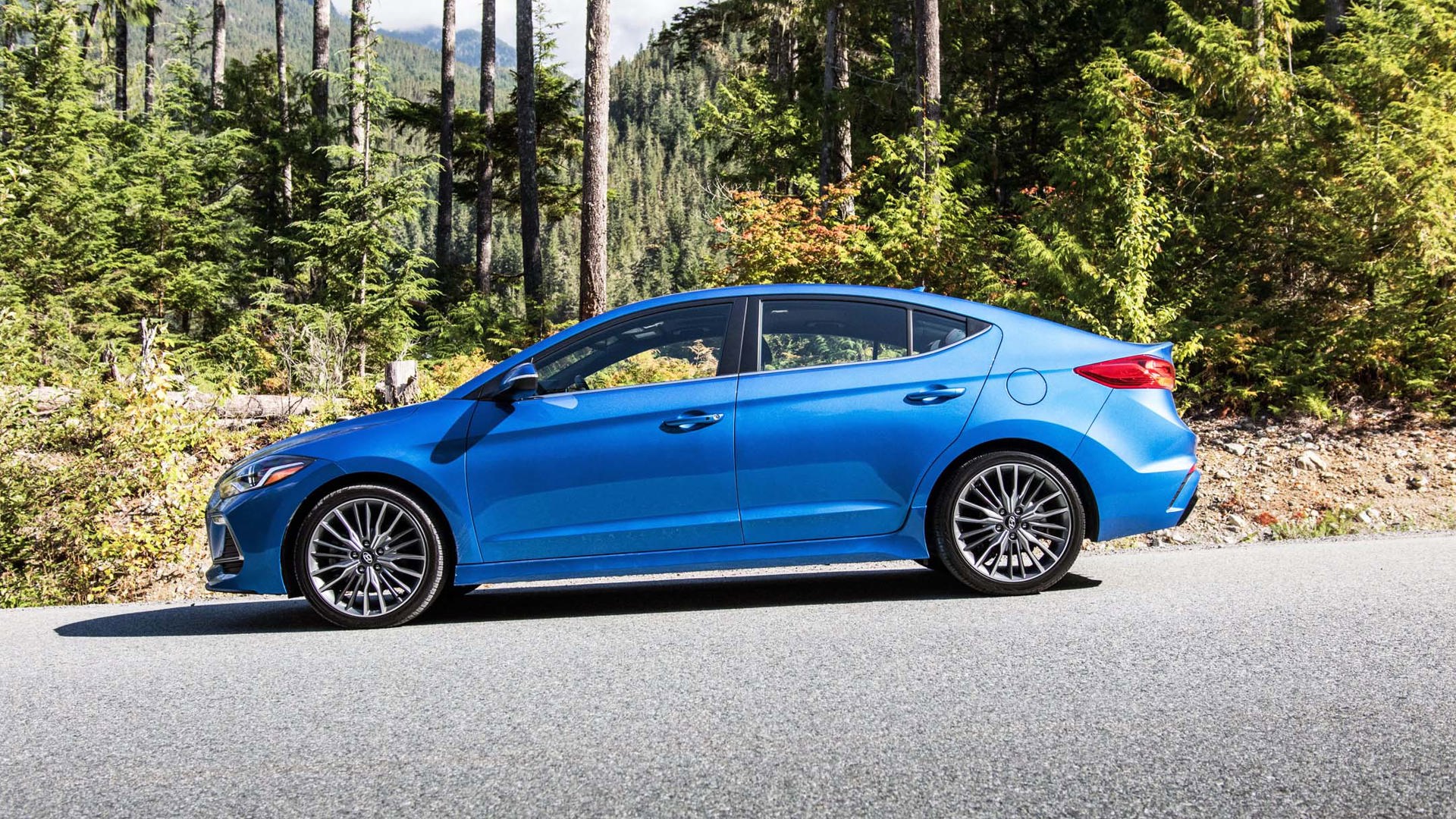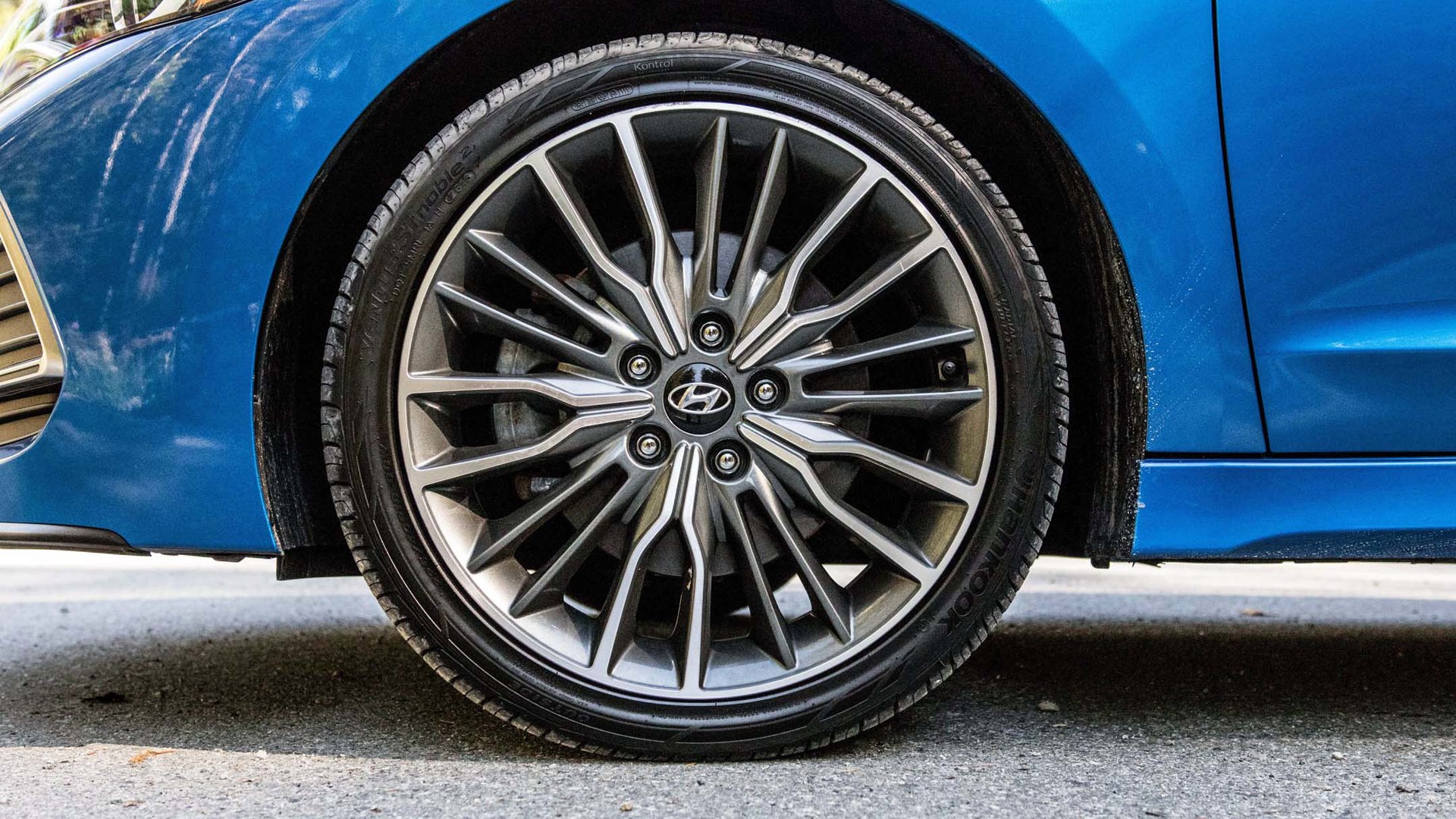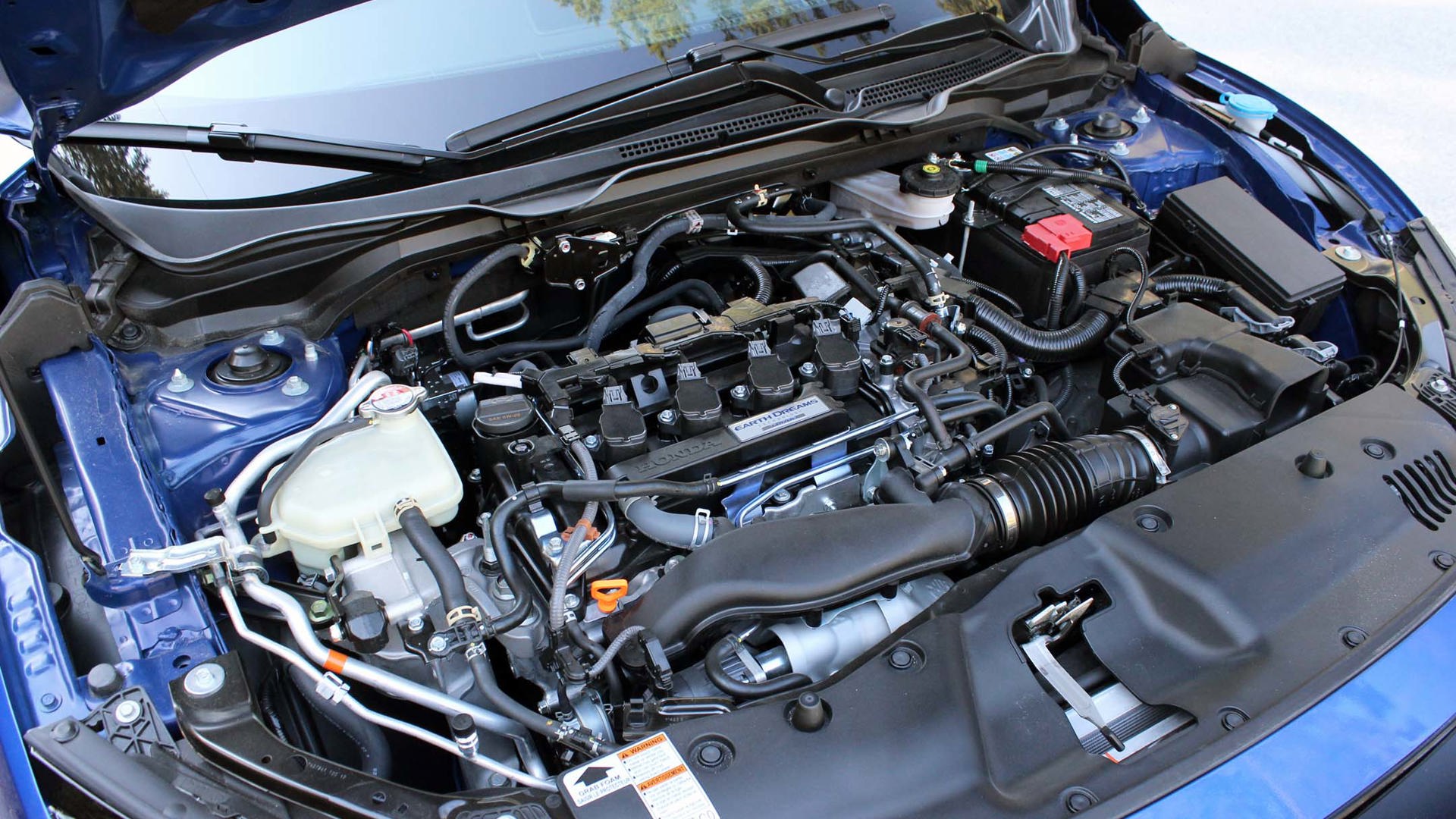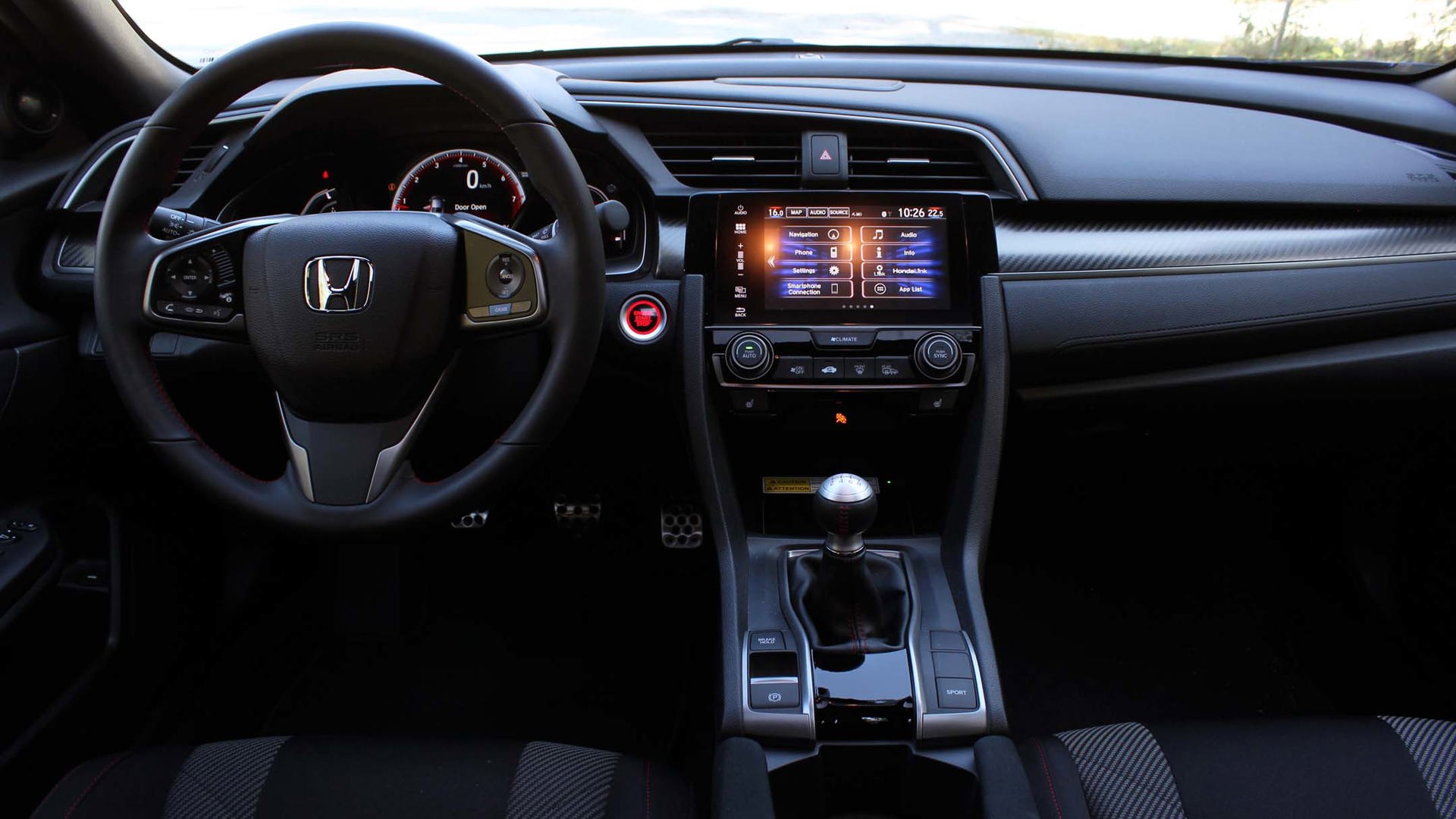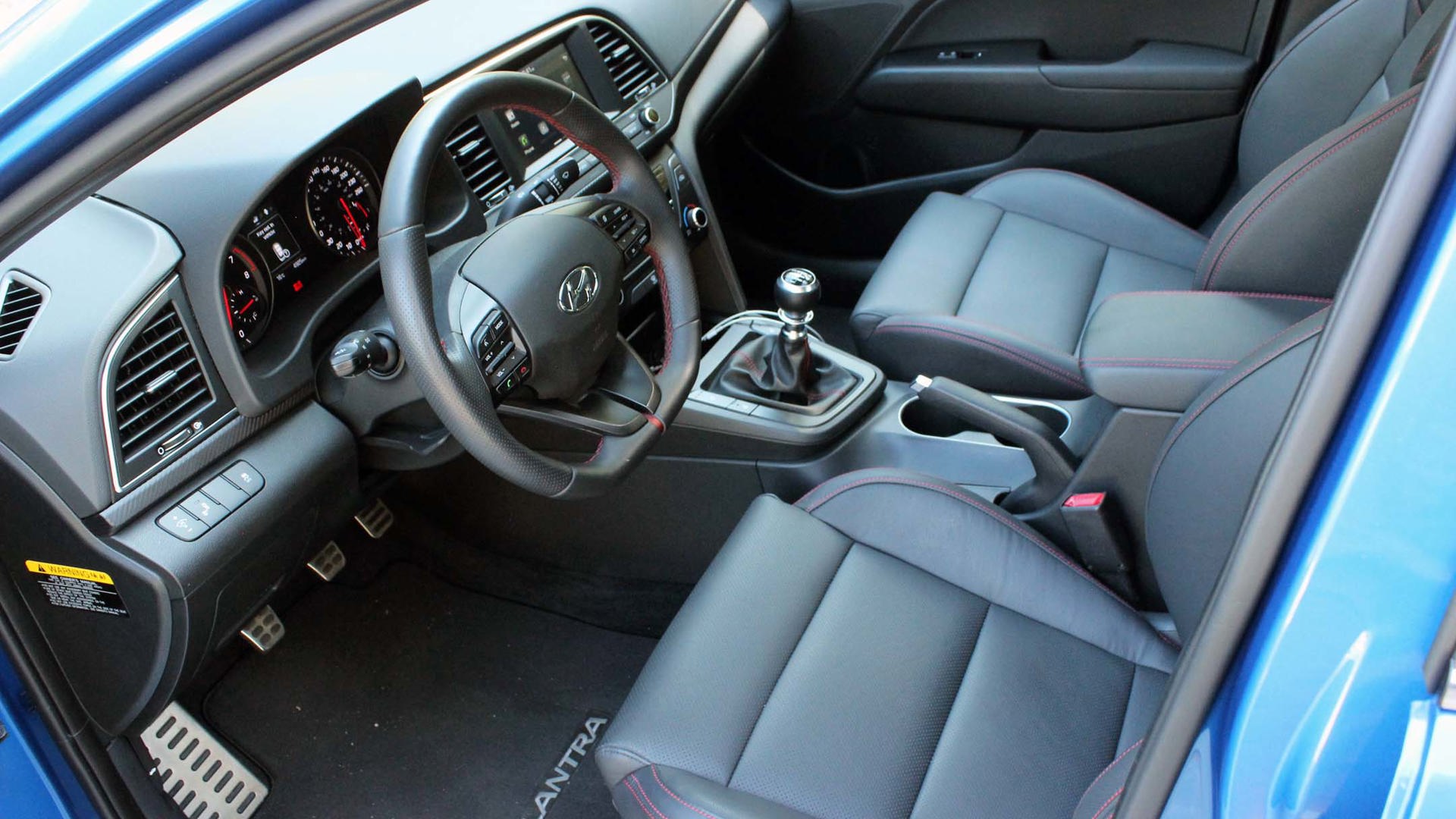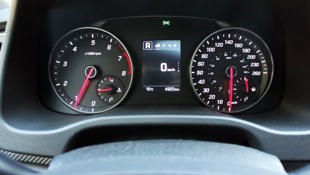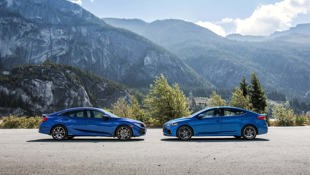Comparison Data
|
2017 Honda Civic Si Sedan
|
2017 Hyundai Elantra Sport
|
|---|---|
|
Engine Displacement
1.5L
|
1.6L
|
|
Engine Cylinders
4
|
4
|
|
Peak Horsepower
205 @ 5,700 rpm
|
201 @ 6000 rpm
|
|
Peak Torque
192 @ 2,100-5000 rpm
|
195 @ 4500 rpm
|
|
Fuel Economy
8.4, 7.4 (L/100 km, City/Highway)
|
10.7, 7.8 (L/100 km, City/Highway)
|
|
Cargo Space
379
|
407
|
|
Base Price
$28,490
|
$24,999
|
|
A/C Tax
$100
|
$100
|
|
Destination Fee
$1,595
|
$1,705
|
|
Price as Tested
$30,185
|
$26,804
|
|
Optional Equipment
None
|
None
|
By Brendan McAleer and Dan Heyman
Dan says
As is always the case when it comes to discussing Honda Civics – of any stripe, I might add – I have to check myself. After all: the Honda Civic was the first car I ever owned, and everyone knows how your first car is always special.
A tougher call than I’d like to admit - Brendan
Thing is, my bias is only so strong and the Civic really doesn’t need much false aggrandizement because bottom line is that it’s just a very good car; years of top sales figures bear that out, but of course there’s so much more to it than that.
And that’s just the regular Civic; the one we’re talking about here is the high-performance variant, 2017 Honda Civic Si. Of course, with the arrival of the Type R hatch it’s not the high-performance variant it once was in North America but by the same token, you can say that with the addition of turbocharged power, its performance creds are given a “boost” with the addition of turbocharged power.
And yet, Honda’s actually a little late to the turbo game, and indeed were beaten to the punch by the manufacturer who’s facing off with them in this particular fight: Hyundai. While the Elantra in particular has never gotten one, Hyundai’s been honing their turbo skills with the likes of the Santa Fe, Sonata, Veloster and Genesis for a few years now so it will be interesting to see if that knowledge gives the 2017 Hyundai Elantra Sport a leg up in this particular bout.
Brendan says
My take here is that we’re watching two everyday sedans face off in a personality contest. Sure, Honda’s late to the turbocharger game, but I’m old enough to remember the era of Turbo decals when car manufacturers decided everything could be improved by slapping a turbine on clunky old engines and cranking up the boost.
I was already impressed with the base Elantra’s behaviour when last I drove it, musing only that the economy-minded engine fell short of what the chassis could do. Now it looks like Hyundai’s answered the clarion call. And hey, a manual!
The Civic, on the other hand, has pulled a swaparoo. Sure, we get boost, but it’s at the expense of VTEC. I’m sure you’ll remember Dan, that it’s not so long ago that we pitted the turbocharged Kia Forte5 against the previous generation Si, and found that the Honda held its own by virtue of mechanical honesty.
A new, more flexible powertrain is no bad thing, but does the zippy little Honda lose its character. And, if so, does that allow room for the upstart Hyundai to come barrelling up the inside?
Styling
Dan says
Brendan’s going to fight me to the death on this one, I know it, but I like the Si’s looks better, bar none. He’s going to go on and on about how the Si belongs on the set of the next Furious movie and so on but that’s fine by me and I just think he needs to loosen up a little. The Si has always been a bit of a boy-racer car, but that’s what makes it so special, and I’d wager that’s what many Si buyers are looking for. Yes, the rear wing’s large and yes, the tailpipe is extremely wide – and for the first time on a Si, centrally-mounted – but the two-tone wheels are just right and the view from the front displays a wide, aggressive stance that looks both modern and imposing. Are the huge rear bumper “intakes” too fake looking? Yeah, I guess you could say that but that’s all I really take issue with, there.
The Elantra, for its part, is a fine looking car if not a particularly exciting one. Sure; the multi-spoke wheels are cool and the subtle trunklid spoiler and rear underbody diffuser (how’s THAT for boy racer, Brend-o?) a nice touch, but even in a Similar shade of blue to our Civic, the Honda’s always going to turn more heads.
Brendan says
Picking a winner on styling Dan? Too soon Junior. It’s not that I disagree that the Si is going to turn more heads, it’s that I (correctly) believe that the current Civic lineup looks like the hangover the night after an anime convention.
To its credit, the Si isn’t quite as zany as the Type R, but then again nothing is. That car makes a Huracan look like a 1998 Toyota Camry. For those who would be considering swapping into a Honda after a couple of years of expensive Volkswagen GTI maintenance, getting past the big wing look is going to take some doing. Personally, I find the most egregious part to be the Diablo-esque centre-mount exhaust. It’s not just overkill for a 1.5L turbo, it’s going to make it a pain to mount a hitch for hauling around bikes.
The Elantra, on the other hand, starts off looking like the H&M version of Audi, and improves from there. Demerits? Like the Honda, those gaping front intakes aren’t doing much. On the other hand, the overall subtlety of the Sport’s various upgrades is to be commended: a little red eyeshadow around the headlights, some muted badging, an exhaust pipe that doesn’t draw attention to itself. Those 18-inch multi-spoke wheels are going to be a pain to keep clean, but they’re attractive.
Overall, the Elantra Sport is the grownup’s choice, while the Si embraces a more youthful look. I’d argue the former is to be preferred, what with the youths having spent all their money on avocado toast and whatnot.
Interior/Comfort
Dan says
Just by looking at it, you get the impression that the Civic is the bigger car, and it does pip the Elantra in the interior volume department by just under 60 litres. That difference can really be felt in the back seats, where the Civic gets added legroom as well as more steeply raked rear seatbacks so you can stretch out a little more. They also come heated as standard. Heated rear seats! In a compact sedan! It’s here that you start to see the Si take advantage of the pieces bestowed upon its head, just by being a member of the very well-equipped Civic family.
Having said that: it’s good that you can make use of the added legroom to slide forward and slouch a little more, as the Elantra actually has a little more rear headroom than does the Civic, and I found myself actually feeling that gulf, as small (as in, a claimed 5 mm small) as it is. Overall, though, the Civic is the rear seat king.
Front seat wise, it’s not so much the space difference that I noticed, but more the seating position itself. Si trim adds a pair of properly-bolstered sport seats, just as it has for the last three generations of the car and they’re incredibly good. They’re not so highly-bolstered to the point you’re sitting atop the bolsters as opposed to actually on the seat cushion below, while the side bolsters do a good job of hugging your ribs without winding you.
They’re standard on the Si, but only come in cloth, as has always been the case. The Elantra, for its part, gets standard leather sports seats in Sport guise, which is a plus for some, not so much for others. Leather, of course, tends to be a little more durable and is always easier to clean than cloth, while cloth can be a little more grippy for when you’re attacking the twisties – something you’ll want to do quite often in both of these, as we’d soon find out – and not as susceptible to temperature fluctuations. The Elantra Sport’s items have also been given slightly larger Side bolsters over normal, but they’re nothing like what’s seen on the Si and you still sit lower in the Honda. Not as good for your view out – the Elantra’s is better – but nice if you like a more cossetting feel from your sporty sedan.
Both cars get heated front seats as well as heated steering wheels, but only the Honda gets automatic climate control, which comes as part of the $2,500 tech package on the Elantra.
Brendan says
A tougher call than I’d like to admit. On first blush, the Elantra Sport matches its upscale exterior with a well-made, somewhat muted interior. It looks a bit old-school Germanic, which is not meant as an insult: with leather here and there and not overdoing it on the carbon-fibre trim, the Sport’s interior should age well.
The mono-spec Civic, on the other hand, exchanges leather for cloth, and is a bit busier. As Dan will note further on, Honda’s take on touchscreen controls looks great in showrooms and grubby after about ten minutes of driving. If you were doing nothing else other than simply peeking in the window at two parked examples, the Elantra would look like the more expensive option – and it’s not.
However, as soon as you slide into the driver’s seat and start looking for the details that make the difference between a driver’s car and just a nicely-equipped machine, the Civic starts pulling ahead. For one thing, its seats are excellent. Both the VW GTI and the Subaru STI could take lessons here, not to mention the cartoonishly over-bolstered Recaros of some of the hot Ford hatchbacks. The Si’s thrones are comfortable, easy to get in and out of, but have properly grippy bolstering which includes metal tabs built into the sides of the seat so the bolster won’t deform under constant use. The seating position is also low, and a low hip-point is to be preferred in a sport sedan. It’s the difference between a sit-in and a sit-on-top kayak.
The Elantra is equally comfortable, but not particularly special. Two possible exceptions are the D-shaped steering wheel, and the fact that you get a proper handbrake. The Si has one of those irritating electronic parking brakes.
Suffice to say that the Elantra always felt like a nice place to be with a few sporty accents, where the Si’s interior felt more like a cockpit. When we get to the drive portion, such might be enough to make the difference.
Tech
Brendan says
Both sedans come really well equipped here, right out of the box. The basic Elantra in particular comes with everything you need, fitted as it is with Apple CarPlay and Android Auto. It’s also got a better setup for USB plug-ins rather than the Si’s fiddly split-level system.
Further, as we’ll cover in the value section, the cost differential between these two cars is such that the tech-equipped Elantra Sport is still cheaper than the Si, and you can get more goodies. The eight-speaker Infiniti audio is a useful upgrade over the six-speaker standard system, and having onboard navigation helps keep you from burning through your data if using the Android or Apple links.
Yes, you have to pay extra in the Elantra for the dual-zone climate control, something that’s standard on the Civic, but I prefer to think that the Sport has a lightly decontented version that still has most of what customers want. A 7.0-inch base screen instead of the upgraded 8.0? No big deal at all.
Dan says
In addition to the climate control and heated seats/wheel, the Si comes standard with back-up cam, navigation, 10-speaker audio, LaneWatch display (whereby your infotainment screen becomes a big blind spot camera as soon as you indicate right), Sirius sat radio and WiFi tethering. You don’t get the adaptive cruise, however, that you do on the top non-Si trims. Apple CarPlay and Android Auto is also standard on both cars.
While we’ve spoken about how the Si benefits from being part of the well-equipped Civic family, it also gets one of the biggest shortcomings: an all-touch display that features small buttons and attracts dust like a magnet. No matter how much I tried – both during this test and during that of the many other Hondas I’ve tested over the last few years – I just couldn’t get used to prodding a non-button to turn by sound system on or off. The way you interact with the Elantra’s system is more traditional, but that’s not to say it doesn’t look a modern piece; the graphics are clear if not quite as bright as the Honda’s, but the buttons are larger and easier to access. It’s a nicely-responsive touchscreen, too and the back-up cam is actually a little clearer on the Elantra than it is on the Honda.
Performance and Handling
Dan says
How does Honda manage to do it, year after year? As the Civic gets more advanced with all manner of electronic doo-dads, blind spot cameras, turbo motors and so on, you still get that feeling that when you’re driving the Civic Si, you’re driving as analogue and granular a car as you’ll find on the market today, right up there with the Mazda MX-5 and Toyota 86, both rear-wheel-drive sports cars that don’t have to find a way to be sporty whilst still maintaining a modicum of practicality as does the front-wheel-drive Civic.
After much deliberation of how this can be, I came to the conclusion that it boils down to Honda’s execution of two specific aspects: the Si’s steering and shift lever action. These are your two most direct links with the car and they become doubly important in small, sporty compacts such as this.
And they have nailed. The shift lever bangs home every cog with authority, and a slick action that gives the impression that there’s a vacuum sucking the shifter into each slot. The steering – though electronically assisted – is direct and well-weighted, one of the best acts of disguising an EPS system I’ve seen thus far. Couple that with the perfect seating position that ensures said controls fall perfectly into hand, and you’ve got a very entertaining drive experience. In the end, all the hubbub surrounding the arrival of a turbocharged motor for the first time to a production Civic actually takes a bit of a back seat to the outstanding dynamics package.
There’s just something to be said for the way the Si responds so quickly to your steering inputs that’s almost impossible to put into words. It takes about two turns of the wheel to go from lock to lock – the last car took almost three turns – which translates to that much more reaction from the chassis when twitch the wheel either way. In the end, it’s just immediate nose-in, with the rear end gamely following suit. All the while, you’re gripping on a chunky wheel whose connection to the rack is oh-so-solid and linear that you have to remind yourself that you’re driving what is essentially a compact hatch.
When you consider the power figures made by the Honda, the need for such a refined chassis becomes clearer. When we reported on the Si after its debut at this year’s New York Auto Show, many of our eagle-eyed readers were quick to point out that the power figures are essentially the same as the last time ‘round. Indeed, at 205 horsepower this latest Si – turbo or no – makes the exact same hp as did the previous model. It does, however, reach peak levels at 5,700 rpm as opposed to a manic 7,000 rpm as used to be the case. It also makes 18 more lb-ft of torque than previous. Still, though; extreme power is not what the Si is about, but as soon as you clip yet another apex oh-so-perfectly, you’ll have a very clear idea of what the ‘17 Si is all about, and it’s fantastic.
You really have to hand it to Hyundai, then, for taking on such a performance beast with the kind of brand equity the Honda has. Having said that, the latest Elantra has been a revelation, and so you can see how Hyundai would have the chutzpah to take on the establishment. Further, in an effort to gain more of an advantage, the Elantra Sport actually made it to market before the Si did. It also gets its own special spot on Hyundai’s website, as if it’s a model unto itself as opposed to a trim of the standard car.
Its 1.6L turbocharged unit makes 201 hp and 195 lb-ft of torque – roughly equivalent to the Si – although you do have to rev it a little higher to get to peak figures. Good, then, that Hyundai has added a sports exhaust system, so at least when you’re reaching those lofty power heights you sound good while you’re at it. It’s actually the better sounding of the two cars.
I also found it to be the slightly softer riding of the two, but that’s not to say it wasn’t willing to participate in a little backroad hijinks as well. The steering is never going to be as good as the Honda’s – the Elantra’s is loose off-centre to the point where I sometimes felt a little nervous about it – but once you do get the steering on your Side, you’ll find crisp turn-in and chassis responsiveness that would be top trumps in the compact sedan category were it not for the existence of the other car in this test.
Unlike the Honda, the Hyundai is available with both a manual and dual-clutch automatic transmission, which may just give it the edge in the eyes of some buyers. We had the six-speed manual, however, which provides a more involving ride but has its shortcomings, most notable of which include a loose-feeling shift lever response and high clutch bite-point. I’ve also had the chance to sample the DCT transmission, and it’s good to the point where I wouldn’t be completely averse to going that way with the Elantra Sport. Is that heresy? Maybe, but being the somewhat more grown-up car of the two, it actually fits. It will cost you an additional $1,500 to get it, however, but that’s a little easier to swallow considering that no matter how you configure your Elantra, it will never cost as much as the Si does.
Brendan says
Just massively impressed with the little Hyundai here. For one thing, it doesn’t have any faux driving modes, just get-in-and-go goodness. The more time I spent in it in the days running up to our day-long shootout, the more I enjoyed it. It also seems much quicker than its 201hp output would suggest, and the way the power comes on has you wringing the engine out to redline.
Judged in a vacuum, it’s frankly excellent. This level of competent, glee-inducing performance combined with a great-looking interior and excellent value bundling on features makes the Elantra an excellent choice. Add in the ability to get a seven-speed dual-clutch gearbox, and Hyundai might just be the unlikely sport compact saviour of the hour.
In short, Hyundai has done here what Nissan keeps failing to do: provide an affordable performance compact that’s genuinely good to drive, yet that’s still comfortable enough for every day. There’s only one slight problem: the Civic Si is better.
I had a chance to sling the Si around both track and street some weeks before sliding into the seat on our favourite backroad, and I’ll confess the experience left me lukewarm. The old Si got better with every mile you drove it, where the new one’s more flexible powertrain just didn’t seem to have the same character. It was fast, sure, but it didn’t have that same joyful delight you used to get in old Honda’s. And, if pressed, I liked the base hatchback better.
However, swapping into the Si right after the Elantra Sport was eye-opening. All the careful little tweaks Honda’s engineers have made to the chassis, steering, and shifting suddenly popped into focus. The engine, too, seems to pull harder in the mid-range than the Sport’s, moreso than its who-cares 4hp advantage. Never mind the horsepower: in true Honda fashion, this car’s delight isn’t in how much thrust you’ve got, but what you do with it.
First, the steering, which is electronically-assisted, and thus dull compared to an old EK-chassis hatch or what-have-you. By old-fashioned standards, it’s a bit numb. Compared to the Elantra’s looser feel the Civic is much sharper. What you lose in detail, you gain in precision output, and it’s not an exaggeration to say that this car nearly matches the Type-R for faithful behaviour. It doesn’t quite have the ultimate grip of its huge-winged big-brother, but the Si can manage as much or more backroad speed as you (or the constabulary) could ever want.
The shifting, too, is excellent, more positive feeling in engagement than the Elantra, with a better clutch uptake. No, the Si doesn’t have any sort of automatic option, dual clutch or otherwise. All that means is that Honda’s engineers have focused on their manual offering and given it just that little push in the right direction.
And then there’s the driving modes. The Si has them, where the Sport does not, but they’re not just faux feel-good nonsense. In fact – something surprising for a sport compact at this price point – the Si even comes with two-mode adjustable dampers. Traction control can’t be completely defeated, unlike in the Type-R, but you’d have to be a nutcase to take away all safety nets on the street. Toggling sport mode let the Si run away from the Elantra as the road got curvier, and it felt happy doing it.
After a long and leafy drive, my mind was made up. All the Sport’s advantages were outweighed by the Si’s drive. Which is not to sell the Elantra short. BC happens to be full of wriggling, technical backroads, but if your commute is not, you won’t be able to unlock the way the Honda shines. However, when both cars were later parked side-by-side, I found myself considering how best to dispose of the Si’s more garish cosmetic bolt-ons, rather than wondering how to get the Elantra tightened up a bit.
Value
Dan says
That, of course, is always going to be an ace up the Hyundai’s sleeve. You can get all that turbocharged goodness, those leather seats and 18-inch wheels for $24,999 at base. The Si starts at $30,241 and while that does get you all the bells and whistles such as navigation and heated rear seats, there’s no automatic option and no way to remove features if you just want the dynamic adds without all the creature comforts. Gaining access to 200 turbocharged horsepower and a sport-tuned chassis rarely happens as inexpensively as it does with the Elantra Sport, and that definitely adds appeal to the plucky little Korean.
Brendan says
No question the Elantra has the value here, but let’s not discount the Civic’s ace-in-the-hole. You need to explain the Elantra Sport to someone unfamiliar with the idea of Hyundai as a brand that can produce genuinely sporty cars (Genesis Coupe notwithstanding). You don’t need to explain what a Civic Si is. It’s a known quantity, and will have great resale down the road.
Then there’s the fuel economy results, which surprised. Mixed mileage results, including the kind of leisurely cruise up the Sea-to-Sky an owner might do of a weekend, resulted in 7.7 L/100 km consumption for the Si and 8.9 L/100 km for the Elantra. Given that Dan and I swapped seats multiple times, real-world mileage should bear out that the Civic has the advantage here.
Conclusion
Dan says
It’s not just about the cost of entry, though, when it comes to the Honda. It’s about the whole experience; how solidly the door closes, while you can visibly see the top seal of the Elantra’s door frame shudder when you slam it shut, for example. Or the way the carbon fibre inserts look that much more real than they do in the Elantra, though some may say they’re a little too present here. The Civic really is the full-on, 4D experience that does a good job of suggesting that it really is a model unto itself, as opposed to a trim of a more mainstream model (which it is). The Elantra, on the other hand, while remaining one of the most exciting sedans Hyundai has ever built, still feels, to me, like it’s more a sum of its parts as opposed to more than the sum of its parts, as is the case with the Honda. Hyundai has made a valiant, well thought-out and gutsy attack on the throne, but King Si has managed to hold the young prince back. For now.
Brendan says
Like I initially thought, it came down to a personality contest. I maintain that the Elantra Sport is the more sensible, grown-up choice. It’s less expensive, it’s nicer inside with regard to layout and luxuries, and it doesn’t look like it was designed by a bunch of people who sit around drinking Coronas and giving thanks for ball-bearing turbos when they say grace.
Regrettably, I must face the music. I’m not as grown-up as I thought I was. The Si’s superior driving dynamics are enough to tip the balance for me, and even though there’s a bit of added expense here, a combination of the right features and good projected resale tips the balance in the Honda’s favour. The Si’s still got it, even if VTEC no longer kicks in, yo.












